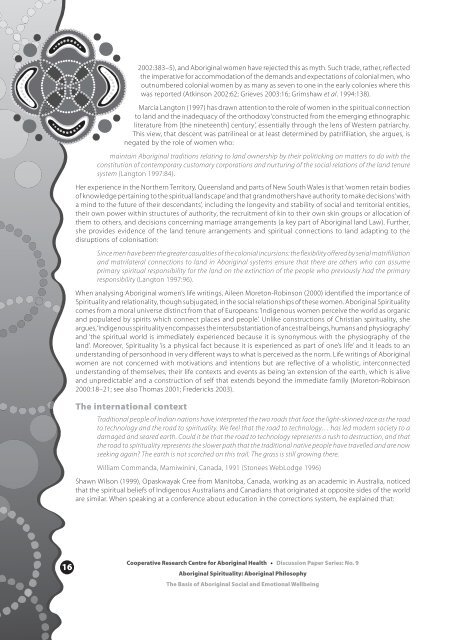DP9-Aboriginal-Spirituality
DP9-Aboriginal-Spirituality
DP9-Aboriginal-Spirituality
You also want an ePaper? Increase the reach of your titles
YUMPU automatically turns print PDFs into web optimized ePapers that Google loves.
2002:383–5), and <strong>Aboriginal</strong> women have rejected this as myth. Such trade, rather, reflected<br />
the imperative for accommodation of the demands and expectations of colonial men, who<br />
outnumbered colonial women by as many as seven to one in the early colonies where this<br />
was reported (Atkinson 2002:62; Grieves 2003:16; Grimshaw et al. 1994:138).<br />
Marcia Langton (1997) has drawn attention to the role of women in the spiritual connection<br />
to land and the inadequacy of the orthodoxy ‘constructed from the emerging ethnographic<br />
literature from [the nineteenth] century’, essentially through the lens of Western patriarchy.<br />
This view, that descent was patrilineal or at least determined by patrifiliation, she argues, is<br />
negated by the role of women who:<br />
maintain <strong>Aboriginal</strong> traditions relating to land ownership by their politicking on matters to do with the<br />
constitution of contemporary customary corporations and nurturing of the social relations of the land tenure<br />
system (Langton 1997:84).<br />
Her experience in the Northern Territory, Queensland and parts of New South Wales is that ‘women retain bodies<br />
of knowledge pertaining to the spiritual landscape’ and that grandmothers have authority to make decisions ‘with<br />
a mind to the future of their descendants’, including the longevity and stability of social and territorial entities,<br />
their own power within structures of authority, the recruitment of kin to their own skin groups or allocation of<br />
them to others, and decisions concerning marriage arrangements (a key part of <strong>Aboriginal</strong> land Law). Further,<br />
she provides evidence of the land tenure arrangements and spiritual connections to land adapting to the<br />
disruptions of colonisation:<br />
Since men have been the greater casualties of the colonial incursions: the flexibility offered by serial matrifiliation<br />
and matrilateral connections to land in <strong>Aboriginal</strong> systems ensure that there are others who can assume<br />
primary spiritual responsibility for the land on the extinction of the people who previously had the primary<br />
responsibility (Langton 1997:96).<br />
When analysing <strong>Aboriginal</strong> women’s life writings, Aileen Moreton-Robinson (2000) identified the importance of<br />
<strong>Spirituality</strong> and relationality, though subjugated, in the social relationships of these women. <strong>Aboriginal</strong> <strong>Spirituality</strong><br />
comes from a moral universe distinct from that of Europeans: ‘Indigenous women perceive the world as organic<br />
and populated by spirits which connect places and people’. Unlike constructions of Christian spirituality, she<br />
argues, ‘Indigenous spirituality encompasses the intersubstantiation of ancestral beings, humans and physiography’<br />
and ‘the spiritual world is immediately experienced because it is synonymous with the physiography of the<br />
land’. Moreover, <strong>Spirituality</strong> ‘is a physical fact because it is experienced as part of one’s life’ and it leads to an<br />
understanding of personhood in very different ways to what is perceived as the norm. Life writings of <strong>Aboriginal</strong><br />
women are not concerned with motivations and intentions but are reflective of a wholistic, interconnected<br />
understanding of themselves, their life contexts and events as being ‘an extension of the earth, which is alive<br />
and unpredictable’ and a construction of self that extends beyond the immediate family (Moreton-Robinson<br />
2000:18–21; see also Thomas 2001; Fredericks 2003).<br />
The international context<br />
Traditional people of Indian nations have interpreted the two roads that face the light-skinned race as the road<br />
to technology and the road to spirituality. We feel that the road to technology… has led modern society to a<br />
damaged and seared earth. Could it be that the road to technology represents a rush to destruction, and that<br />
the road to spirituality represents the slower path that the traditional native people have travelled and are now<br />
seeking again The earth is not scorched on this trail. The grass is still growing there.<br />
William Commanda, Mamiwinini, Canada, 1991 (Stonees WebLodge 1996)<br />
Shawn Wilson (1999), Opaskwayak Cree from Manitoba, Canada, working as an academic in Australia, noticed<br />
that the spiritual beliefs of Indigenous Australians and Canadians that originated at opposite sides of the world<br />
are similar. When speaking at a conference about education in the corrections system, he explained that:<br />
16<br />
Cooperative Research Centre for <strong>Aboriginal</strong> Health • Discussion Paper Series: No. 9<br />
<strong>Aboriginal</strong> <strong>Spirituality</strong>: <strong>Aboriginal</strong> Philosophy<br />
The Basis of <strong>Aboriginal</strong> Social and Emotional Wellbeing


